Geckeler K.E., Nishide H. (Eds.) Advanced Nanomaterials
Подождите немного. Документ загружается.

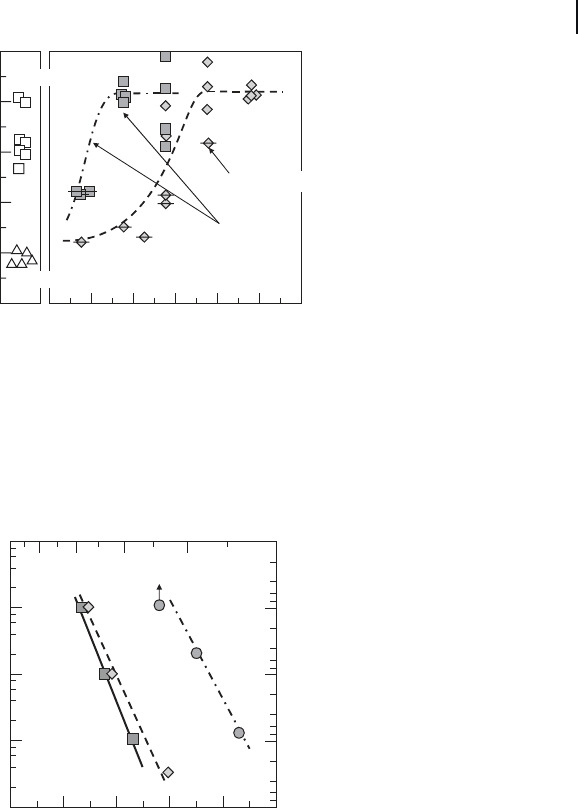
17.6 Valid Conditions 569
elevated temperatures. Apparent activation energies of the crack healing can be
evaluated from Figure 17.16 . The question is why the activation energy of Si
3
N
4
/
SiC composite differs from those of alumina/SiC and mullite/SiC composites. The
reason could be the crack healing of Si
3
N
4
/SiC composite is driven by the oxidation
of SiC as well as Si
3
N
4
. Using these values, one can estimate the time for which
a semi - elliptical crack of 100 μ m in surface length can be completely healed at
several temperatures.
1100 1200 1300 1400 1500 1600 1700
0
200
400
600
1000
800
Flexural strength (MPa)
Cracked strength
Smooth strength
Temperature (K)
Crack-healed strength
(300 h)
Crack-healed strength
(10 h)
Figure 17.15 Relationship between crack - healing temperature
and strength recovery for alumina/15 vol% 0.27 μ m SiC
particles composite. (Centered line symbols indicate
specimens fractured from the crack - healed zone.)
5678910
0.001
0.01
0.1
1
10
100012001400160018002000
Crack-healing Temperature, T
H
(K)
1
10
100
1000
0.1
Minimum crack-healing time, t
H
(h)
10 000/T
H
(K
−1
)
1/t
H
(h
−1
)
Si
3
N
4
/SiC
(Q = 277 kJ)
Al
2
O
3
/SiC
(Q = 334 kJ)
Mullite/SiC
(Q = 413 kJ)
Figure 17.16 Arrhenius ’ plots on the crack healing of several
ceramics having the self - crack healing ability.
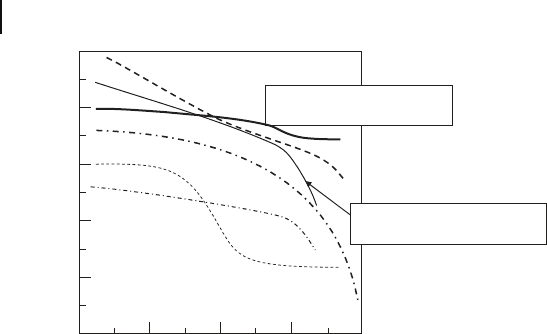
570 17 Self-healing of Surface Cracks in Structural Ceramics
The refractoriness of the crack - healed zone restricts the determination of the
upper limit of the valid temperature range of self - crack healing. The temperature
dependence of the fl exural strength of the several typical ceramics crack healed
[22, 25, 28, 36, 37] is shown in Figure 17.17 . Except the dependence of Si
3
N
4
/20 wt%
SiC particles composite containing 8 wt% Y
2
O
3
as sintering additives, all depend-
ences of the crack - healed specimens have the temperature at which the strength
decreases abruptly, and this has been determined as the temperature limit for
strength. The temperature limit is affected by the features of the oxide formed by
the self - crack healing. The commercial sintered SiC [36] was found to have con-
siderably low temperature limit of 873 K because the formed oxide is in glassy
phase. Modifying the sintered additives to Sc
2
O
3
and AlN, Lee et al . [37] succeeded
in improving the temperature limit of the crack - healed zone signifi cantly. The
similar behavior was observed in the Si
3
N
4
/20 wt% SiC particles composites [25] .
When the sintered additive is 5 wt% Y
2
O
3
and 3 wt% Al
2
O
3
, the formed oxide and
grain boundary are in glassy phase. Alternatively Si
3
N
4
/20 wt% SiC particles com-
posite containing 8 wt% Y
2
O
3
as sintering additives forms the crystalline oxide,
such as Y
2
Si
2
O
7
by crack healing. The difference gives rise to the difference in the
temperature limit. Both alumina containing 15 vol% SiC particles composite [28]
and mullite containing 15 vol% SiC particles composite [22] form the crystalline
phase because the formed oxide reacts with the matrix and forms mullite. These
temperature limits are summarized in Table 17.2 .
The temperature range at which the self - crack healing is valid is limited by the
crack - healing rate and the high - temperature mechanical properties. Assuming
that fracture by the second damage allows complete healing of surface cracks
introduced by the fi rst damage in 100 h, one can evaluate the valid temperature
range of the self - crack healing, as listed in Table 17.3 .
200 600 1000 1400 1800
Temperature (K)
Flexural strength (MPa)
0
200
400
600
800
1000
Si
3
N
4
/20 vol% SiC composite
(8 wt% Y
2
O
3
)
Si
3
N
4
/20 vol% SiC composite
(5 wt% Y
2
O
3
+ 3 wt% Al
2
O
3
)
Commercial SiC
Al
2
O
3
/15 vol%
SiC composite
Mullite/15 vol%
SiC composite
Sintered SiC composite
(Sc
2
O
3
+ AlN)
Figure 17.17 Temperature dependences of the fl exural
strength of several typical crack - healed ceramics.

17.6 Valid Conditions 571
17.6.3
Stress
Stress applied to the components is also one of the most important factors to
decide the valid condition of the self - crack healing. Structural components gener-
ally suffer various kinds of stresses. The applied stress is possible to cause the
slow crack growth. If the applied stress exceeds the critical value, it would rise to
catastrophic fracture. Therefore, it is important to know the threshold stress that
could be safely applied to the cracks during self - crack healing.
Ando et al . [41] reported for the fi rst time that the surface crack in the mullite
containing 15 vol% SiC particles composite can be healed, although the tensile
stress is applied to the cracks. Their results revealed that the crack healing occurs,
although the precrack is grown by the applied stress, and the specimens crack
healed under stress had the same strength as the specimens crack healed under
no stress and at same temperature. Furthermore, Ando et al . [42] reported that
surface cracks in the mullite containing 15 vol% SiC particles composite can be
healed even though dynamic stress such as cyclic stress, opens and closes the crack.
Nakao et al . [43] investigated the threshold stresses during self - crack healing for
several oxide ceramics. For example, the threshold static stress during crack
healing for a semi - elliptical surface crack (surface length = 100 μ m) in alumina
containing 15 vol% SiC particles has been determined to be 150 MPa, as shown in
Figure 17.18 [43] .
Table 17.2 Temperature limit of several ceramics.
Materials Temperature limit (K)
Si
3
N
4
/20 vol% SiC particles composite (8 wt% Y
2
O
3
) 1573
Si
3
N
4
/20 vol% SiC particles composite (5 wt% Y
2
O
3
+ 5 wt% Al
2
O
3
) 1473
Alumina/15 vol% SiC particles composite 1573
Mullite/15 vol% SiC particles composite 1473
SiC sintered with Sc
2
O
3
and A/N 1673
Commercial SiC sintered 873
Table 17.3 Valid temperature region of self - crack healing for several ceramics.
Materials Valid temperature range (K)
Si
3
N
4
/20 vol% SiC particles composite (8 wt% Y
2
O
3
) 1073 – 1573
Alumina/15 vol% SiC particles composite 1173 – 1573
Mullite/15 vol% SiC particles composite 1273 – 1473
SiC sintered with Sc
2
O
3
and A/N 1473 – 1673
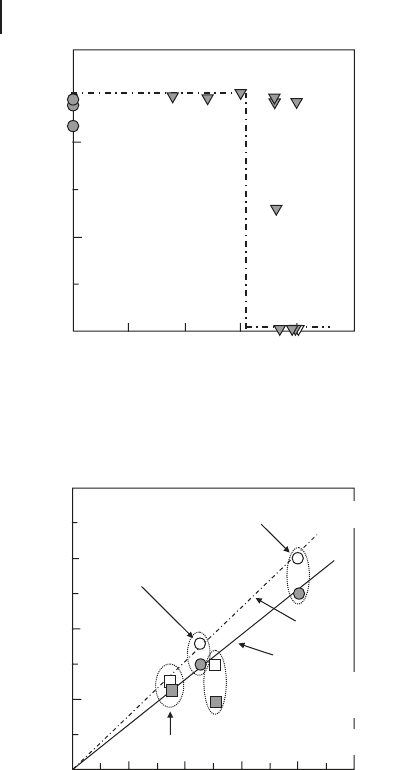
572 17 Self-healing of Surface Cracks in Structural Ceramics
Figure 17.18 demonstrates that the tensile static stress of 180 MPa is possible
to fracture the specimen during crack healing, whereas the stress less than 150 MPa
never fractures the specimens during crack - healing.
Figure 17.19 shows the determined threshold stress as a function of the fl exural
strength of the specimen containing the same surface crack for several cracks in
the oxide ceramics – SiC composite [43 – 46] . Except the threshold stresses of mullite
containing 15 vol% SiC whiskers composite, all data satisfi es the proportional rela-
tion, although the crack healings were subjected to different conditions. The crack
healing ability for mullite containing 15 vol% SiC whiskers composite has been
50 100
0
200
400
600
Applied stress (MPa)
Crack-healed strength at 1473 K (MPa)
0 150 250200
Figure 17.18 Crack - healing behavior at 1473 K under static
stress for alumina/15 vol% SiC particles composite.
100 200
0
100
200
400
Cracked strength (MPa)
Threshold stress during crack-healing (MPa)
0 300 500400
Mullite/15 vol% SiC particle composite
300
Mullite/15 vol% SiC
whisker composite
Alumina/20 vol% SiC whisker composite
Alumina/15 vol% SiC
particle composite
Static
Cyclic
Figure 17.19 Relation between threshold stress during crack
healing and the corresponding cracked strength.

17.7 Crack-healing Effect 573
found to be so low that the crack healing part was weaker than the other parts as
only partly welding occurs, not satisfying the proportional relation. The propor-
tional constants for the relations between the threshold static and cyclic stresses
between the cracked strength have been found to be 64 and 76%, respectively. The
threshold stress imposes an upper limit to the crack growth rate, thereby limiting
the crack length to less than the critical crack length before the crack healing starts.
This implied that the crack growth behavior of all specimens is time dependent
rather than cyclic dependent at high temperature. Therefore, applying static stress
could be confi rmed to be the easiest condition for fracture during the crack healing
under stress, and the threshold stresses of every condition during the crack healing
have been found to be the threshold static stresses. The stress intensity factors at
the tip of the precrack during the crack - healing treatment, K
HS
, were estimated.
Since a tensional residual stress was introduced during precracking by using an
indentation method, it is necessary to consider the stress intensity factor of the
residual stress, K
R
, as expressed by the following equation:
KKK
HS ap R
=+
(17.4)
where K
R
can be evaluated by using the relation proposed by Kim et al . [47] and
K
R
= 0.35 × K
IC
. Also, by interpolating the threshold static stress during the crack
healing and the geometry for the precrack into Newman – Raju equation [48] , one
can obtain K
ap
. From the evaluation, it was found that ceramic components having
the adequate crack healing ability can be crack healed under the stress intensity
factor below 56% fracture toughness.
17.7
Crack - healing Effect
17.7.1
Crack - healing Effects on Fracture Probability
The crack - healing can simplify the complexity in the fl aws associated with fracture,
because surface cracks that are severest fl aws in ceramic are completely healed.
As a result, a fracture probability can be easily described after the crack - healing.
Furthermore the crack - healing has a large contribution to decrease the fracture
probability.
Fracture probability is one of the most important parameters for structural
components. If the fracture probability is too high, one needs to either change the
design or substitute high strength materials. The fracture probability can be
obtained from the failure statistics. As indicated in Section 17.2 , ceramics contain
many fl aws that can vary in size and fi guration, causing the wide strength distribu-
tion. Thus the empirical approach needs to describe the strength distribution of a
structural ceramic. Once the strength of a material is fi tted to the distribution, the
fracture probability can be predicted for any applied stress. A common empirical
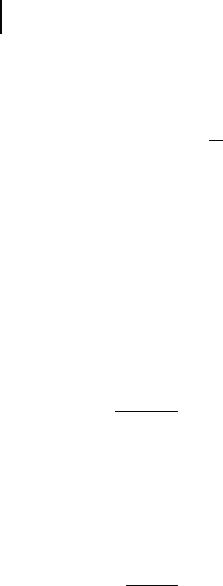
574 17 Self-healing of Surface Cracks in Structural Ceramics
approach to describe the strength distribution of a structural ceramic is the Weibull
approach. The two - parameter Weibull function, which is given by
F
m
σ
σ
β
()
=− −
⎛
⎝
⎜
⎞
⎠
⎟
⎧
⎨
⎩
⎫
⎬
⎭
1exp
(17.5)
can express the strength distribution of structural ceramics well, where F ( σ ) is the
fracture probability at the tensile stress of σ , m the Weibull modulus, and β the
scale parameter. The Weibull modulus describes the width of the strength distri-
bution. High Weibull modulus implies that the strength has a low variability.
Values of m for ceramics are in the range of 5 – 20. The scale parameter describes
the stress when F ( σ ) = 63.2%. To analyze the strength distribution, Equation ( 17.5 )
is usually expanded as follows:
ln ln ln ln
1
1−
()
⎛
⎝
⎜
⎞
⎠
⎟
=−
F
mm
σ
σβ
(17.6)
Thus, a plot of the left - hand side of Equation (17.6) has a linear relation versus
the natural logarithm of the strength. In such a procedure tire, a fracture probabil-
ity is needed for each test specimen. This is usually estimated using
F
i
n
σ
()
=
−
+
03
04
.
.
(17.7)
The strength data of n specimens are organized from weakest to strongest and
given a rank i with i = 1 being the weakest specimen. Equation (17.7) is well known
as median rank method.
As an example, the Weibull plot of the crack - healed alumina containing 20 vol%
silicon carbide (SiC) particles composite is shown in Figure 17.20 . The healed
crack is a semi - elliptical surface crack having a surface length of 100 μ m and a
depth of 45 μ m. In comparison, those of the as - cracked specimen and the smooth
specimen having a miror fi nish surface are shown in Figure 17.20 . Assuming that
the data obey the two - parameter Weibull function, one can apply a least - squares
fi tting. From the obtained line profi les, the values of m and β can be obtained
for the crack - healed specimens the as - cracked specimens and the smooth
specimens.
The crack - healing causes slight increase to the value of m compared to the
smooth specimens. Furthermore, the strength distribution of the crack - healed
specimen is in a good agreement with the two - parameter Weibull function,
although that of the smooth specimen differs from the function signifi cantly. The
fl aw population in ceramics leads to this behavior. The Weibull modulus m of
the crack - healed specimen was smaller than that of the as - cracked specimen.
All the as - cracked specimens fractured from a crack introduced by the Vickers
indentation, while fractures of most crack - healed specimens occurred outside of
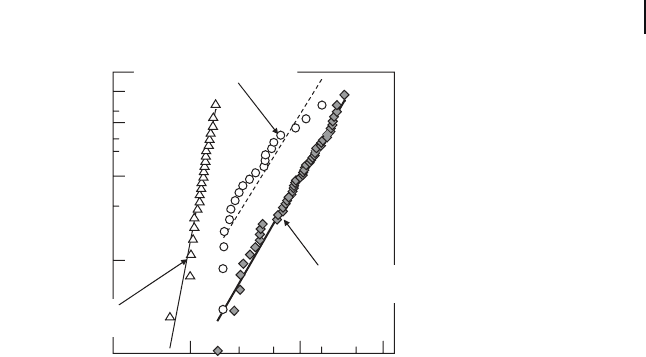
17.7 Crack-healing Effect 575
1
10
50
90
99
200100 500
1000
Flexural strength (MPa)
Fracture probability (%)
Smooth strength
(m = 4.3, b = 394, n = 20)
Crack-healed strength
(m = 4.6, b = 544, n = 50)
Cracked strength
(m = 13.8, b = 228, n = 23)
Figure 17.20 Weibull plot of the crack - healed alumina
containing 20 vol% silicon carbide (SiC) particles composite.
the crack - healed zone, as shown in Figure 17.3 b, because cracks were completely
healed. Since embedded fl aws as the fracture initiation of the crack - healed
specimens have different sizes, the fracture stresses exhibit a large scatter.
This specimen was tested at room temperature and exhibited the fracture
stress of 526 MPa. To improve the reliability and the quality of the structural
ceramics, it is therefore necessary to remove the specimens with large embedded
fl aws by proof test, even if surface cracks were completely healed. The scale
parameter of the crack - healed specimens has a higher value than that of the as -
cracked specimens as well as that of the smooth specimens, because cracks intro-
duced by machinings which existed even in the smooth specimens, were also
completely healed.
To show the considerable merit of the crack healing, the fracture probabilities
of three specimens (smooth specimens, as - cracked specimens, and crack - healed
specimens) for the proof test stress of 435 MPa were compared. The fracture prob-
abilities of the smooth specimens, the as - cracked specimens, and the crack - healed
specimens were 80, 100, and 30%, respectively. Therefore, it can be concluded that
the crack healing drastically increases the survival probability by the proof test,
and thus increases the working stress of structural ceramics.
17.7.2
Fatigue Strength
The effect of the self - crack healing on the fatigue strength is greater than that on
the monotonic strength. The fatigue degradation of ceramics progresses by the
stress corrosion cracking at the tip of cracks as mentioned in section 17.2 . There-
fore the presence of surface cracks affects strongly the fatigue strength. Figure
17.21 [50] shows the dynamic fatigue results of the crack - healed mullite containing
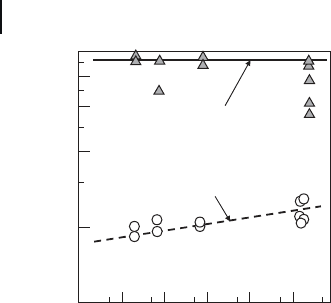
576 17 Self-healing of Surface Cracks in Structural Ceramics
15 vol% SiC whiskers and 10 vol% SiC particles composite with that of the com-
posite having a semi - elliptical crack of 100 μ m in surface length. From logarithmic
plots of the dynamic strength versus stressing rate, the effect of the crack healing
on the fatigue behavior can be clearly understood. The positive slope implies that
the slow crack growth occurs. As the data on the specimens containing the surface
crack shows the positive slope, the slow crack growth has been included in the
fatigue behavior. On the other hand, the data on the crack - healed specimen is
almost constant over the whole stressing rate. Therefore, the crack healing makes
the fatigue sensitivity decrease signifi cantly. Actually, the fracture initiator in the
crack - healed mullite containing 15 vol% SiC whiskers and 10 vol% SiC particles
composite under the every stressing rate is an embedded fl aw, which did not grow
under the applied stress.
In high temperature fatigue, there is another interesting phenomenon, in order
that the self - crack healing occurs at the same time as fatigue damage. For example,
Figure 17.22 [50] shows a logarithmic plot of life time in terms of the applied stress
for the crack - healed mullite containing 15 vol% SiC whiskers and 10 vol% SiC
particles composite at 1273 K. In general, that is, the slow crack growth is included,
the life time increases as the applied stress decreases. However, all the crack -
healed test specimens survived up to the fi nish time of 100 h obeying the JIS
standard [51] under static stresses of 50 MPa less than the lower limit of the
monotonic strength at the same temperature. Alternatively, the specimens frac-
tured at less than 100 s under stresses corresponding to the lower limit of the
fl exural strength. This fracture is not fatigue, but rather rapid fracture. Therefore,
it is confi rmed that the crack - healed composite is not degraded by the static fatigue
at 1273 K. The behavior would result from the fact that self - crack healing occurs
rapidly compared with the fatigue damage.
0.001 0.01 0.1 1 10 100
Stress rate (MPa s
−1
)
100
200
400
600
800
Fracture stress (MPa)
1000
As-cracked
Crack-healed
1000
Figure 17.21 Dynamic fatigue results of the crack - healed
mullite containing 15 vol% SiC whiskers and 10 vol% SiC
particles composite with that of the composite having a
semi - elliptical crack of 100 μ m in surface length.
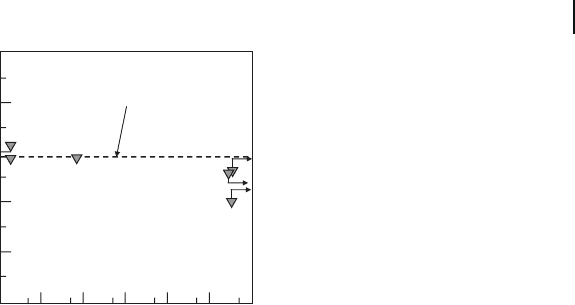
17.7 Crack-healing Effect 577
17.7.3
Crack - healing Effects on Machining Effi ciency
An important alternative aspect is that the self - crack healing is a most valuable
surface treatment. Applying the crack - healing process into the manufacturing for
ceramic components can reduce the manufacturing cost. Machining processes
included in the manufacturing reduce the reliability of the components [52]
because it causes many cracks to the surface of the component. To remove the
nonacceptable cracks, fi nal machining processes, such as polishing and lapping,
are generally required. Although these processes leave behind many minute
cracks, these are expensive processes. It is, therefore, anticipated that substituting
the creak - healing process for the fi nal machining processes leads to economical
manufacturings for ceramic components secured with high reliability.
Figure 17.23 [53] demonstrates that the nonacceptable cracks introduced by a
heavy machining can be completely crack healed. The machining cracks were
introduced at the bar specimens surface of alumina/20 vol% SiC whiskers com-
posite by a ball - drill grinding. The ball - drill grinding was performed along the
direction perpendicular to the long side of the specimens, as shown in shown in
Figure 17.6 , which consequently fabricated a semi - circular groove whose depth
and curvature were 0.5 and 2 mm, respectively. As a result, the machined speci-
mens contained many machining cracks perpendicular to the tensile stress at the
bottom of the semi - circular groove. The horizontal variable is a cut depth by one
pass, which is an indicator of the machining effi ciency. For example, 14 to 40
cycles are needed to fabricate the semi - circular groove by the grinding with the
cut depth by one pass of 15 and 5 μ m, respectively. Alternatively, the vertical axis
indicates the local fracture stress of the machined specimens and the machined
specimen healed. From the load as the specimens fractured, P
F
, the section
0
200
400
600
800
1000
Applied stress, s
ap
(MPa)
Time to failure, t
f
(s)
10
2
10
3
10
4
10
5
10
6
10
1
10
0
Lower limit
of monotonic strength
Figure 17.22 Logarithmic plot of life time in terms of the
applied stress for the crack - healed mullite containing 15 vol%
SiC whiskers and 10 vol% SiC particles composite at 1273 K.
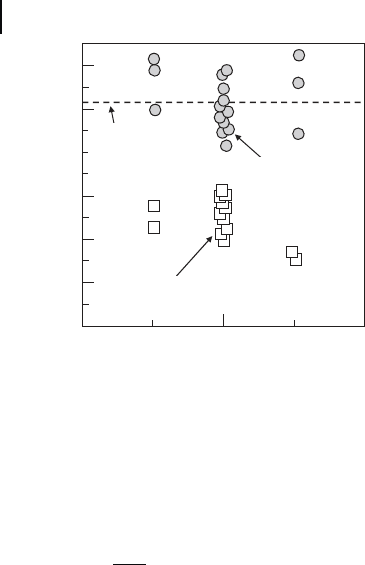
578 17 Self-healing of Surface Cracks in Structural Ceramics
Local fracture stress (MPa)
Cut depth by one pass (µm)
01020
0
200
400
600
800
1000
1200
Means fracture
strength of smooth
specimen healed
Machined specimen
Machined specimen
healed
Figure 17.23 Effect of depths of cut by one pass on the local
fracture stress at room temperature of the machined
specimens healed.
modulus, Z , and the stress concentration factor, α , the local fracture stress at the
bottom of the semi - circular groove, σ
LF
, was evaluated as follows:
σ
α
LF
F
=
Pl
Z4
(17.8)
where l is a span length. Under this geometry, the value of Z and α were 4.2 and
1.4 [54] , respectively. The local fracture stress of the machined specimens decreased
with increasing the cutting depth. This behavior implies that the cut depth by one
pass also means the degree of the machining heaviness. Throughout the range of
the cut depth by one pass a complete strength recovery was found to be attained
by the crack - healing treatment for 10 h at 1673 K, because these average strengths
were almost equal to that of the complete crack - healed specimens [35] . The crack
healing is possible for relatively large cracks initiated by a heavy machining for
cutting depths up to 15 μ m. However, the heavy machining for cutting depths
above 15 μ m makes the diamond grain to drop out of the ball drill signifi cantly,
reducing the machining effi ciency. Therefore, with a simple operation of heating,
one can ensure the reliability over ceramic components machined by the limiting
conditions of the grinding tool (ball - drill). To not cause the outstanding strength
to decrease by fabricating the semi - circular groove, it is necessary to perform not
only on machining with the cut depth by one pass of less than 5 μ m but also on
lapping at the bottom. Thus, a high machining effi ciency can be attained by the
use of the crack - healing process.
It is important to note the difference in the optimized condition between the
crack healing for indented cracks and the machining cracks. The optimized crack
healing condition for the indentation cracks in alumina/20 vol% SiC whiskers
composite was found to be 1573 K for 1 h [53] . However, the crack healing above
